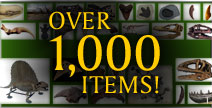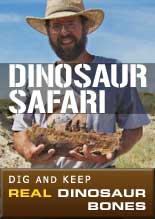
Diplodocus Chevron Bone
Jurassic Age, Utah
Chevrons are a series of bones on the underside of the tail of dinosaurs, reptiles and a few other kinds of animals. Chevrons are attached to the bottom of the tail (caudal) vertebra. Their main function is to protect critical elements in the tail such as nerves and blood vessels from being damaged when the animal either supports its weight on its tail, or pushes it against a hard surface to propel itself. Diplodocus was a giant sauropod 79-85 feet long weighing 13-16 tons.
Diplodocus was a long-necked, whip-tailed giant, measuring about 90 feet (27 m) long with a 26 foot (8 m) long neck and a 45 foot (14 m) long tail, but its head was less than 2 feet long. It was among the longest land animals ever. Its nostrils were at the top of its head and it had peg-like teeth, but only in the front of the jaws. Its front legs were shorter than its back legs, and all had elephant-like, five-toed feet. One toe on each foot had a thumb claw, probably for protection. A fossilized Diplodocus skin impression reveals that it had a row of spines running down its back.
Diplodocus was more lightly built than the other giant sauropods, and may have weighed only about 10-20 tons. Its backbone had extra bones underneath it, which had bony protrusions running both forwards and backwards (anvil shaped), a "double beam", probably for support and extra mobility of its neck and tail. It may have used its whip-like tail for protection.
Gastralia (hanging belly ribs) are thin, fragile ribs that helped support and protect the internal organs (like the lungs) in the middle area of the body. These ribs were not attached to the backbone; they were attached to the skin in the belly area.
Diplodocus was an herbivore (it ate only plants). It must have eaten a tremendous amount of plant material each day to sustain itself. It swallowed leaves whole, without chewing them, and may have swallowed gastroliths (stones that remained in its stomach) to help digest this tough plant material. It had blunt teeth, useful for stripping foliage.
Its main food was probably conifers, which were the dominant plant when the large sauropods lived. Secondary food sources may have included gingkos, seed ferns, cycads, bennettitaleans, ferns, club mosses, and horsetails. (from enchangedlearning.com)
resin
8.75x4x1.5 inches
Item 3971
Category: Replicas
Type: Bones
Phylum: Vertebrates
Class: Dinosaurs
MORE PHOTOS:




Now Over 1,000 Items!
PrehistoricStore.com offers the largest selection of replica fossils and other fossil-related products anywhere in the world!
Download a Full Catalog (3MB PDF)
OVER 260 PAGES OF REPLICAS AND MORE!
